Library of Congress's Blog, page 139
November 13, 2015
Serving Up Food Collections
(The following story, written by Library culinary specialist Alison Kelly, is featured in the November/December 2015 issue of the Library of Congress Magazine, LCM. You can read the issue in its entirety here.)
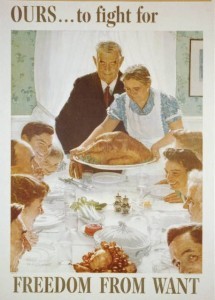
Painter Norman Rockwell’s “Freedom from Want,” Office of War Information poster, 1943. Prints and Photographs Division.
The Nation’s Library offers a veritable feat of food-related collections.
Whether you’re researching what was served at the Pilgrims’ first Thanksgiving or tracing the history of genetically modified foods, you can find it in the Library of Congress.
The topic of food—interdisciplinary in nature and woven into many aspects of our lives—is well-represented in the Library’s extensive collections of cookbooks, scholarly works, journals, pamphlets, posters and bibliographies on food history. Researchers can also consult the Library’s primary-source materials— from anonymous diaries to presidential papers.
Cookbooks are an invaluable resource for food history. They offer clues about markets, agriculture, nutrition, regional and cultural differences, immigration, technological change and more. Some of the world’s outstanding cookbooks and other works on gastronomy—from the 15th through the 19th centuries—came to the Library in the early 1940s when Arvill Wayne Bitting donated the 4,346-volume collection assembled by his wife, Katherine Golden Bitting (1868-1937), a food chemist for the Department of Agriculture and the American Canners Association. The Library’s cookbook collections range from Maestro Martino’s handwritten 15th-century manuscript (“Libro de arte coquinaria”) in the Bitting collection to contemporary full-color works like “Modernist Cuisine” (2011) and “Cambridge World History of Food” (2014).
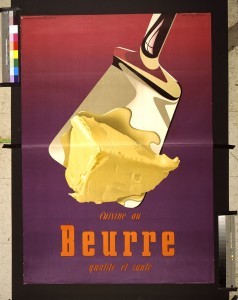
Advertising poster for butter, Donald Brun, 1951. Prints and Photographs Division.
American cooking is a special strength of the Library’s collections. Titles include “American Cookery” (1796) by Amelia Simmons. Considered to be the first truly American cookbook, the volume is notable for recipes that included native American ingredients such as molasses, pumpkin and cornmeal. Simmons’ “Pompkin Pudding” baked in a crust is the basis for the American classic, pumpkin pie.
Numerous influential American cookbooks followed—from Lydia Maria Francis Child’s “The Frugal Housewife” (1829) to Irma Rombauer’s “Joy of Cooking,” published in 1931 and followed by six editions.
Many of the Library’s cookbooks have regional focus, with specialized recipes from New England, the American Southwest, the Great Lakes and, of course, the South. An example is one of the first published works on cooking by an African-American author, “What Mrs. Fisher Knows about Old Southern Cooking, Soups, Pickles, Preserves, etc.” (1881) by Abby Fisher.
Many regional cookbooks have been used to raise funds for local schools, churches or women’s clubs. The community cookbooks comprise a portion of the Library’s food holdings.
Wartime cookbooks could be their own genre. “The Confederate Receipt Book: a compilation of over one hundred receipts adapted to the times” (Richmond, 1863), was the only cookbook published in the South during the Civil War. Cookbooks published during the first and second World Wars encouraged homemakers to do their part in contributing to the war effort on the home front by stretching their budget with recipes such as mock sausage.
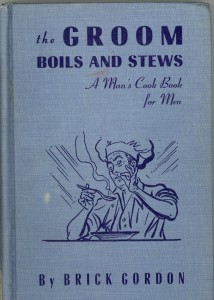 Coca-Cola Company’s entire collection of historic television commercials dating to 1950. The national and international advertisements reveal much about world cultures—and their eating and drinking habits— over the past five decades.
Coca-Cola Company’s entire collection of historic television commercials dating to 1950. The national and international advertisements reveal much about world cultures—and their eating and drinking habits— over the past five decades.Over the past decade, many culinary experts have spoken at the Library on topics ranging from Somali, Turkish, Egyptian and Pan-African cuisine to the fortune cookie. Many notable chefs have spoken at the Library’s National Book Festival. These presentations can be viewed on the Library’s website or its YouTube channel.
November 11, 2015
Inquiring Minds: VHP Marks 15 Years Preserving Veterans’ Stories
(The following is a story written by Mark Hartsell for the Gazette, the Library of Congress staff newsletter.)
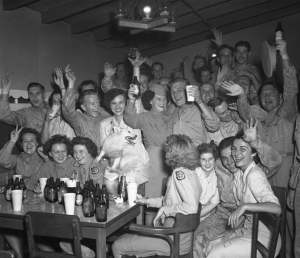
Servicemen and servicewomen raise a toast to victory on VJ Day in 1945. Veterans History Project.
A missing Air Crew Report, author Dennis Okerstrom says, provides plenty of facts about losses in air combat: type of aircraft, names and ranks of crew members, a flight plan. Those facts can’t, however, reveal war’s human dimension – what it’s like to actually get shot down in combat.
“It cannot begin to convey the terror, or the courage, or the sense of loneliness experienced by the young men who suf- fered events such as their aircraft being shot from the sky,” Okerstrom said.
For that, researchers need firsthand accounts of the men and women in uniform who were there – stories like those preserved in the Veterans History Project (VHP) at the Library of Congress.
Recently, VHP reached a milestone: its 15th anniversary of collecting, preserving and making accessible the remembrances of the veterans who fought America’s wars, from World War I through Iraq and Afghanistan. In the coming months, the project will hit another milestone: 100,000 individual collections, donated by veterans and their families.
VHP marked the anniversary with a launch of a new online feature, “VHP at 15: Collections Over the Years” and with a display in the Great Hall of photos drawn from the collections.
“Over the last 15 years, the Veterans History Project has developed into a rich archive brimming with the insights and emotions of a diverse legion of America’s veterans,” VHP Director Bob Patrick said. “It is very satisfying to hear of the value placed upon VHP by researchers and educators as well as the appreciation expressed by veterans and their families that these stories will be accessible for generations to come.”
About half of those who use the collections onsite hold a personal, not professional, interest in the material, VHP reference specialist Megan Harris said – just “visiting” the collection of a loved one or trying, perhaps, to learn more about the POW experiences of a father who passed away without really talking about what happened.
“That is pretty powerful,” Harris said. “This draws them in in a way that you don’t see every day. They feel really compelled to do that.”
Most others are researchers carrying out a professional mission: academics, authors, filmmakers, journalists and representatives of historical or federal institutions.
Defense POW/Missing Personnel Office investigators, for example, draw on VHP collections in their efforts to provide a full accounting of missing servicemen and servicewomen. The National Museum of the U.S. Army intends to use VHP collections in the new museum planned for Fort Belvoir, Virginia.
Pulitzer Prize-winning author Rick Atkinson drew upon VHP collections for two volumes of his World War II Liberation Trilogy, “Guns at Last Light” and “Day of Battle.” Filmmakers Ken Burns and Lynn Novick used the collections for their seven-part World War II miniseries, “The War,” and for their upcoming Vietnam War documentary.
Okerstrom, a literature professor at Park University in Missouri, used the collections for two books that explore World War II air campaigns, “Project 9: Birth of the Air Commandos in World War II” and “Dick Cole’s War: Doolittle Raider, Hump Pilot, Air Commando.”
In many cases, Okerstrom said, the veterans he hoped to interview already had passed away. That left VHP collections as the only source for some of the stories he wanted to tell and for the little details that help make history come alive – such as actor Jackie Coogan, a pilot during World War II, regaling comrades with stories of Hollywood starlets.
“VHP offers a well-documented, cross-referenced collection of interviews that simply doesn’t exist anywhere else,” Okerstrom said. “This is not to diminish the importance of records repositories in other places, but I know of no other place to find so many interviews of so many of America’s veterans.”
The majority of VHP collections – and about two-thirds of research conducted onsite – relate to World War II. Still, a significant portion deals with later conflicts: About 3,700 of the collections come from veterans of the Iraq and Afghanistan wars.
Author Larry Minear drew heavily upon VHP collections for his book “Through Veterans’ Eyes: The Iraq and Afghanistan Experience,” a narrative of the impact of those two wars on veterans such as Marine Sgt. Dax Carpenter, who was badly injured in Iraq and struggled for years at home to get benefits.
“Without the accounts of the experiences of the wars told in first-person terms, my research would have been an exercise in speculation, lacking the rigor rightly expected of social-science undertakings,” Minear said. “What my book seeks to convey is not my own voice but that of soldiers themselves. Proceeding inductively from data to conclusions is of the essence.”
Others use the collections to explore timeless themes like love and war – the relationships, for example, between husbands and wives and parents and children in wartime correspondence.
Christina Knopf, an associate professor at SUNY Potsdam, has used VHP collections to produce a series of research papers about the rhetoric of relationships found in war letters.
During one two-week visit to the Library, she photographed some 5,000 letters from 21 different collections – data she’s only beginning to explore for a project she hopes to turn into a book.
“I took a sabbatical in order to visit the LOC and I was overwhelmed by the choices available to me for research, Knopf said. “The staff was enormously helpful – and that is another benefit of the VHP.”
Whatever use is made of the collections, Okerstrom said, the important thing is to preserve these stories before the veterans who tell them are gone.
“These were ordinary men and women who defeated the best that Germany and Japan had to offer, then came home to get back to their pre-war lives,” Okerstrom said. “They hung up their uniforms and didn’t talk about what they had done, usually viewing their service as unremarkable.
“Today, we recognize just what their service and sacrifice have meant to us all, and their stories need to be preserved for future generations.”
November 10, 2015
LC in the News: October 2015 Edition
In October, the Library of Congress celebrated a major milestone – Chronicling America, a free, online searchable database of historic U.S. newspapers, posted its 10 millionth page. To mark the milestone, the Library published a series of lists on its social media featuring interesting and off-beat content from the online archive. Several outlets picked up the stories or utilized the resource for lists of their own.
The Atlantic called the resource “one of the best time capsules online.”
“The database is a rich resource, but it’s also the best kind of Internet rabbit hole: You go in looking for one thing, and encounter a dozen fascinating oddities along the way,” wrote reporter Adrienne Lafrance.
“It took about eight years for Chronicling America, a database of historically significant American newspapers launched by the Library of Congress and the National Endowment for the Humanities, to log its 10 millionth newspaper page—not too long considering it took decades for all that news to happen,” wrote Lily Rothman for Time. Included in the story were headlines from 10 major moments in American history.
Washington Post reporter Abby Ohlheiser said, “I am very grateful that the Library of Congress’s researchers found this gem of a debate in their archives this week,” following a post on a series of cat-related headlines, including one on a “bitter war being waged over felines.”
The Atlantic’s City Lab came up with its own list on the history of happy hour.
The Los Angeles Times looked at newspapers from California in the digitized collection and highlighted some of the news of bygone days.
“Small moments, those, but such minutiae make up most people’s lives,” wrote reporter Scott Martelle. “And it’s fascinating to trace the arc back decades, distilling context for how we live today.”
The Daily Oklahoman highlighted the contribution of the Oklahoma Historical Society’s contribution of 300,000 historical state newspapers that are part of the collection.
“Chronicling America’s success in bringing historic Oklahoma newspapers to life was a turning point for the Oklahoma Historical Society’s mission to collect, preserve and share the history of the state of Oklahoma,” said Oklahoma Historical Society Director of Research Chad Williams.
In other collection news, the Library acquired photographer Robert Dawson’s images of public libraries.
“His extensive visual survey can help us understand the varied and changing roles of public libraries today, in all their different sizes and locations, from storefront rooms to grand civic spaces; from crowded book mobiles to cutting edge designs,” Helena Zinkham, Library of Congress director for collections and services, told Hyperallergic. She added that a “hundred years from now, the survey will still be a valuable mirror. The future viewers will just be looking at the images from their own frame of reference and be able to notice more than we might today, such as which kinds of buildings and services endured; which disappeared; and which were preserved as reminders of another era, of library roots.”
Time also ran a piece and included several images from the collection.
Also in October, David Mao began serving as acting Librarian of Congress. Both American Libraries Magazine and the GW Hatchet (the newspaper of Mao’s alma mater The George Washington University) caught up him to discuss his new role.
“There are lots of opportunities here at the Library of Congress, so interested students should look into what we have available and consider working here because it really is a fabulous institution,” Mao told the GW Hatchet. “If you work hard, stay focused and strive for a particular goal, then you will eventually get there.”
Also recently appointed, or awarded as it were, was the 2015 John W. Kluge Prize for Achievement in the Study of Humanity. Recipients were Jürgen Habermas and Charles Margrave Taylor. The Washington Diplomat covered the ceremony.
November 5, 2015
A Whole New Blog
Today we welcome the newest member of the Library’s blog family. World’s Revealed: Geography & Maps at the Library of Congress will highlight cartographic objects from the Library’s collections that “sometimes go beyond what usually ends up in exhibits and in textbooks and bring to the forefront uncataloged objects that have never before been placed online.”
The Library’s Geography and Map Division contains more than 6 million maps in addition to a wide array of atlases, globes, raised relief models, archives, a vast collection of digital data and a GIS research center. The blog will explore the past, present, and future of maps and mapping, including sharing latest finds and new acquisitions.
Take a look at the first post.
10 Stories: Monkeys! Chronicling America
In celebration of the release of the 10 millionth page of Chronicling America, our free, online searchable database of historical U.S. newspapers, the reference librarians in our Serials & Government Publications Division have selected some interesting subjects and articles from the archives. We’ve been sharing them in a series of Throwback Thursday #TBT blog posts.
Today we return to our historical newspaper archives for stories about monkeys. And who doesn’t like monkeys?
[image error]
Long before Planet of the Apes: “If Monkeys Had Become Men,” detail from the Richmond Times-Dispatch, June 22, 1913.
“Monkeys on Trial”
Locals in Benares, India, demand that a judge issue a warrant for the arrest of “three monkeys, names unknown, on the charge of theft and causing mischief.” The offending monkeys were said to be “the greatest thieves and robbers in the whole City of Palaces.” Columbus Journal, Nov. 20, 1895.
“Do Apes Make ‘Monkey-Chain’ Bridges?”
Professor Gudger debunks a 300-year old myth of how the little guys climb over each other to cross “alligator-infested streams.” Washington Times, May 18, 1919.
“If Monkeys Had Become Men”
During the first decades of the 20th century, evolutionary theory that man and ape shared a common ancestor was the subject of many lengthy opinion pieces in the popular press, including this one in the Richmond Times-Dispatch, June 22, 1913.
“The New Fad: Monkeys”
In the same publication, a somewhat less harsh view of our simian friends: “Society ladies have discarded their Chows and their Griffins for the chattering company of the Marmoset.” Richmond Times-Dispatch, July 10, 1921.
“Exterminating Monkeys for Fashion’s Freak”
The Morning Tulsa Daily World of Aug. 6, 1922, is appropriately horrified at the practice of hunting and killing a species of monkey for dress trimmings.
“A Monkey’s Vengeance”
Granted, it’s in the fiction section, but here’s a lesson on why you don’t want to cross a group of monkeys. Los Angeles Herald, June 24, 1906.
“Suddenly a Hairy Monster Sprang Into the Room”
The harrowing account of an attack on a family by a chimpanzee, escaped from the home of E.W. Knowlton, “millionaire patent medicine manufacturer … [and] collector of simians.” Washington Times, Nov. 23, 1919.
“The Chimpanzee That Goes to University”
In the interest of fairness, here is the story of Susie, a well-mannered and educated ape. San Francisco Call, April 23, 1911.
“Studying the Monkey Mind”
A profile of Melvin E. Haggerty, “the young Hoosier scientist of Harvard University and the investigations he has been making … at the local zoo into the capacity and activities of the simian mind.” St. Paul Appeal, Sept. 5, 1908.
“Prof. Shepherd’s Experiments with Two Intelligent Apes”
Another scientist discusses his findings. “Their clever tricks and man-like actions lead him to conclude that they have a low form of reasoning, crude powers of ideation, sympathy and even a sense of humor.” Not to mention dapper style. Check out that top hat! Omaha Daily Bee, Nov. 7, 1915.
Speaking of Chronicling America, the National Endowment for the Humanities (our partner in the project) has launched a nationwide contest, challenging you to produce creative web-based projects using data pulled from the newspaper archives website. We’re looking for data visualizations, web-based tools or other innovative web-based projects using the open data found on Chronicling America. NEH will award cash prizes, and the contest closes June 15, 2016.
Launched by the Library of Congress and the National Endowment for the Humanities (NEH) in 2007, Chronicling America provides enhanced and permanent access to historically significant newspapers published in the United States between 1836 and 1922. It is part of the National Digital Newspaper Program (NDNP), a joint effort between the two agencies and partners in 40 states and territories. Start exploring the first draft of history today at chroniclingamerica.loc.gov and help us celebrate on Twitter and Facebook by sharing your findings and using the hashtags #ChronAm #10Million.
November 2, 2015
Opening Day For the Library
Until 1897, the Library of Congress was housed in the U.S. Capitol Building itself. Librarian of Congress Ainsworth Rand Spofford (186497) was the first to propose that the Library be moved to a dedicated building. He also was instrumental in establishing the copyright law of 1870, which placed the Copyright Office in the Library and required anyone seeking a copyright to provide two copies of the work to the institution. Largely as a result of Spoffords vision, the Librarys burgeoning collection outgrew its space in the Capitol Building. The large Library room filled very quickly, and overflow was moved to the Capitol attics and along the basement corridors. By mid-decade, Spofford was putting volumes along the walls of committee rooms, down the first- and second-floor corridors and against the public staircases.

Builders at work above the second level of the Library of Congress Thomas Jefferson Building during its construction. Dec. 3, 1891. Prints and Photographs Division.
On Nov. 1, 1897, at 9 a.m., the new Library building (now known as the Thomas Jefferson Building) officially opened to the public 25 years after Spofford had begun his entreaty. Several days later, the transfer of Library materials some 800 tons into the new building was completed. While the items awaited sorting, counting and classification, much was scattered about, lining hallways and covering floors.
The building itself was an architectural wonder, a gorgeous and palatial monument to its [America] national sympathy and appreciation of literature, science and art, according to a guidebook published at the time. News of the opening of the new Library made the pages of many newspapers. A search through the newspapers in Chronicling America uncovered many headlines about the new building.
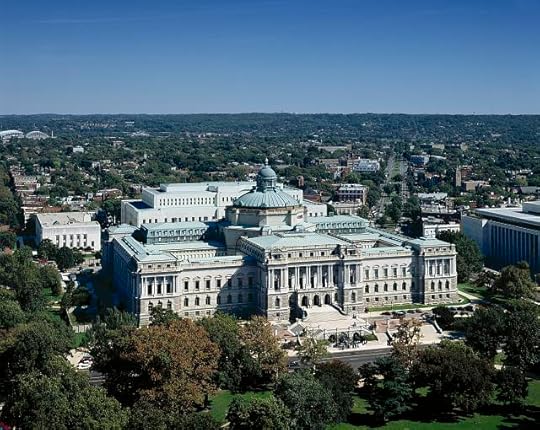
Library of Congress’s Thomas Jefferson Building taken from the Dome of the U.S. Capitol. Photo by Carol M. Highsmith, between 1980 and 2006. Prints and Photographs Division.
The Library of Congress, lately completed, at Washington, D.C., is the most imposing and beautiful, architecturally considered, of any United States Department building, or any building of like character in the world. Beside it the Louvre of Paris, depository of the worlds treasures of paining and sculpture, takes a second place. The National Tribune, July 29, 1897
According to the Nov. 2 issue of The Times, it was raining on the day the Library opened, and about 1,200 visitors came. There is only one restriction on the visitor. As he enters he sees a sign, which, if it were alive, would have a forefinger on its lips. As it is dead, cold type, it merely says Keep quiet, a pleasing variation of the bucolic and eternal Keep off the grass. In that sole respect it is a melancholy place. You go in and you want to read.

Restoration specialist at work on art at the Library of Congress Thomas Jefferson Building, Washington, D.C. Photo by Carol M. Highsmith, between 1980 and 2006. Prints and Photographs Division.
An article from the Evening Star discussed in detail the diversity of literary tastes that frequented the Library. From those whose mental food is entirely of the fiction sort to the large number of men and women in Washington who aspire to become writers to a fiery and nervous man who will unhorse the whole civil service reform idea, the men and women at the reading tables are diverse enough in appearance, character and in the nature of the library studies and investigations.
A month or so after the new Library building opened, a bill was introduced in Congress to change the name of the Library to the national library. According to a Dec. 16 article in the Saint Paul Globe, The present theory of the institution is that it is an adjunct of congress, for the convenience and comfort of the members, much as are the barber shops, etc. But public taxation pays the bills; the copyright regulation supplies the American books, and many people have come to regard the institution as too great and far too important in its magnificent new quarters to be an information bureau for congress and of but incidental service to the great student public throughout the country.
The Library would later add two other buildings to its campus: the John Adams Building in 1939 and the James Madison Memorial Building in 1981. In 1986, work began on a massive renovation of the Thomas Jefferson Building as it approached its one 100th birthday in 1997.
October 30, 2015
Lets Take a Spooky Road Trip!
America is full of weird and spooky places, and what better time to highlight some of them than Halloween! The Library’s collections have a wealth of materials on all kinds of topics, so it wasn’t hard to find places worthy of a frightful road trip!

The non-functioning fountain within an artificial pond called “Lake Tuendae” at Zzyzx. Photo by Carol M. Highsmith, 2012. Prints and Photographs Division.
Zzyzx (pronounced zye-zex), located in San Bernadino County, California, was once the site of a health spa in the early 20th century. Founded by evangelist and self-proclaimed medical doctor Curtis Howe Springer in 1944, the Zzyzx Mineral Springs and Health Spa was to be known as the last word in health.
Heres where it gets a bit shady. Springer acquired the 12,000 acres of federal land, located in the Mojave Desert, by filing a mining claim, which the government later invalidated. He made a fortune selling his useless medicines and cures. In addition, Springers natural hot springs were completely fake they were heated by hidden boilers.
Regardless, the health spa was a success for decades, expanding to a 60-room hotel, church, private airstrip and even a castle. In 1974, the government finally caught on to the King of the Quacks (as designated by the American Medical Association), and shut his enterprise down claiming Springer had no true claim to the land. He spent 49 days in jail for selling bogus meds and ended up retiring to Las Vegas. Zzyzx was taken over by the Bureau of Land Management and is now the site of California State Universitys Desert Studies Center.

Home in the ghost town of Bodie, California. Photo by Carol M. Highsmith, 2012. Prints and Photographs Division.
Also in California is the town of Bodie, a once glorious mining town located about 75 miles southeast of Lake Tahoe. A great example of a genuine ghost town, whats left today is preserved in a state of arrested decay, with buildings and interiors remaining as they were left.
William S. Bodey discovered gold here in July 1859. It was not until 1874 that the great potential wealth of the district became promising. Bodie reached its pinnacle by 1879-80 when the population was estimated at 10-12,000 and when the production from the mines on Bodie Bluff was at its peak. Highgrading, or taking gold, was done so openly that the town was a magnet for criminals, and the The Bad Man From Bodie became synonymous for the lawless inhabitants.

The San Francisco call., July 07, 1907. Chronicling America.
By 1883, Bodies glory days were on the decline. Two major fires destroyed a good bit of the town, mines were closing and residents were feeling the effects of Prohibition and the Depression. With the onset of World War II, the school and post office were closed, and the last residents left town.
The town became a state historic park in 1962 and has been designated as a California Historic Site, as well as a National Historic Site.
Speaking of abandoned places, theres nothing spookier than an abandoned castle. And, for some reason, castles and heartbreak go hand-in-hand.
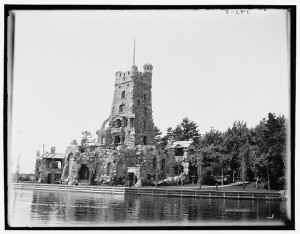
Alster Tower, part of Boldt Castle. Photo by Detroit Publishing Co., 1901. Prints and Photographs Division.
Situated in the famed 1000 Islands region of New York sits Boldt Castle, a 120-room estate complete with tunnels, Italian gardens and a drawbridge. The castles history, however, is shrouded in tragedy. George C. Boldt, rich proprietor of the famed Waldorf Astoria Hotel, began building the grand chateau for his beloved wife Louise. Sadly, in 1904, Louise passed away suddenly, and Boldt immediately ceased construction. He never returned to the island, leaving the structures as a decaying monument to his lost love. In 1977, Thousand Islands Bridge Authority acquired the property and restored it for public use.
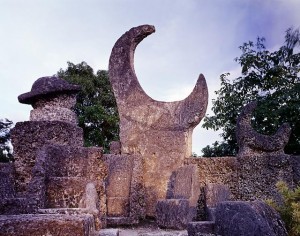
Coral Castle. Photo by Carol M. Highsmith, between 1980 and 2006. Prints and Photographs Division.
Another such castle is Coral Castle, located in Homestead, Florida. After Edward Leedskalnin was jilted by his fiancée, he left his home country of Latvia for America. Settling in Florida, he began a decades-long task of single-handedly building a massive rock castle. Allegedly he never let anyone watch him while he worked, but several teenagers reported they saw the short-statured and thin man move massive pounds of stone like hydrogen balloons.
Legend had it that the castle was built using magic, psychic energy or even alien technology, although that was refuted by Leedskalnins friend, Orval Irwin, who also wrote a book about Coral Castle.
According to an article from LiveScience, more than 1,000 tons of oolite limestone was quarried and sculpted into a variety of shapes, including slab walls, tables, chairs, a crescent moon, a water fountain and a sundial. In addition, the property featured a perfectly balanced stone gate that was easily opened despite its weight.
Leedskalnin opened the property in 1923 for tours, and he worked on the castle until his death in 1951. The place remains open for tourists and is included on the National Register of Historic Places.
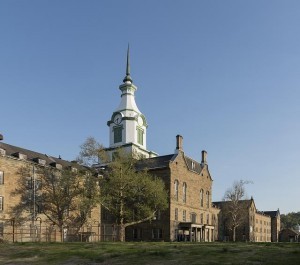
The Trans-Allegheny Lunatic Asylum in Weston, West Virginia. Photo by Carol M. Highsmith, May 3, 2015. Prints and Photographs Division.
Derelict insane asylums and penitentiaries are often popular places for the ghost adventurers. The East Coast has a number of them.
The Trans-Allegheny Lunatic Asylum, located in Weston, West Virgina, served as a sanctuary for the mentally ill from 1864 to 1994. Initially, the facility was intended to house only 250 patients, but at its peak in the 1950s, some 2,400 lived within its walls.
In the early days of medicine, mental health was largely misunderstood and mistreated. Stories are rampant with barbaric practices and treatments, and the Trans-Allegheny Lunatic Asylum had a reputation for being a very violent place. And, as such, the facility is reported to be haunted. A National Historic Landmark, the asylum is open for regular and ghost tours.
Also reportedly haunted is Eastern State Penitentiary, located in Philadelphia. The facility was once the most famous and expensive prison in the world but stands in ruins today.
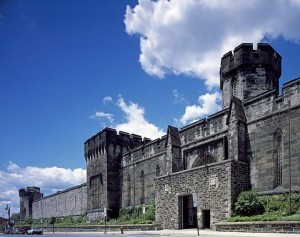
Eastern State Penitentiary, Philadelphia, Pennsylvania. Photo by Carol M. Highsmith, between 1980 and 2006. Prints and Photographs Division.
Opened in 1829, Eastern State was a technological marvel. Inmates lived in complete isolation, but their cells were centrally heated, with running water, a flush toilet and a skylight. Adjacent to each cell was a private outdoor exercise yard contained by a 10-foot wall. Inmates were hooded whenever they were outside of their cells to further their isolation and penitence. The menacing façade of the prison implied that physical punishment took place behind the walls.
And, for some prisoners who broke the rules, there were harsh punishments indeed. According to this NPR article, inmates were subjected to water baths, in which inmates were dunked then hung out on a wall in winter until ice formed on the skin; the mad chair, which bound an inmate so tightly that circulation was cut off; or even the iron gag, in which an inmate’s hands were tied behind the back and strapped to an iron collar in the mouth.
This system was abandoned in the early 1900s, and Eastern State invoked a more integrated system with prisoners sharing cells and working together.
Notable prisoners included gangster Al Capone and bank robber William Francis Sutton.
The prison closed in 1971, after it became too costly to repair and operate. In 1994, it opened to the public with daily tours. Since then its been the site of exhibitions, movies and even a haunted house.
Sources: Historic American Buildings Survey (Library of Congress), roadtrippers.com, roadsideamerica.com, bodie.com, boldtcastle.com, trans-alleghenylunaticasylum.com, easternstate.org.
October 29, 2015
10 Stories: Scary Stuff! Chronicling America
In celebration of the release of the 10 millionth page of Chronicling America, our free, online searchable database of historical U.S. newspapers, the reference librarians in our Serials & Government Publications Division have selected some interesting subjects and articles from the archives. We’ve been sharing them in a series of Throwback Thursday #TBT blog posts.
To commemorate Halloween on Saturday, we return to our historical newspaper archives for alarming tales of the unexpected and a few spooky pranks thrown in for fun.
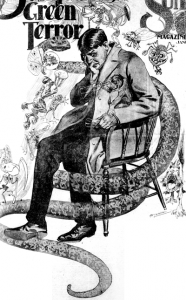
In the grip of the Green Terror! From the San Francisco Call, January 20, 1901.
“A New Halloween Game: The Shivers”
Wherein one passes carefully “prepared-to-make-one-shiver” items from hand to hand, without seeing what they are. (Obviously the source of that old peeled-grapes-as-eyeballs gag.) New York Tribune, October 26, 1919.
“The Spirit of Halloween”
Tips on celebrating the holiday (although frankly, this seems to be an excuse to print photos of a pretty girl). San Francisco Call, October 26, 1902.
“Mars Peopled by One Vast Thinking Vegetable!”
As reported in the Salt Lake Tribune, October 13, 1912. It doesn’t appear to be a Great Pumpkin, but be careful it doesn’t send spaceships to land in Grover’s Mill, N.J., on Halloween night…
“Terror in the Country: An Automobile Is Coming!”
The Richmond Times Dispatch of March 6, 1904, shows the small-town alarm caused by one of those newfangled horseless carriages. Run!
“Breaking the Death-Grip of a Drowning Person”
An unintentionally murderous monster may be swimming beside you in a public pool. Here’s how to save yourself, courtesy of Miss Adeline Trapp, America’s greatest endurance swimmerwho, presumably, has had to fight off a number of these types. Chicago Day Book, August 8, 1913.
“Is San Francisco in the Grip of the Green Terror?”
Not a masked marauder of the radio waves, but an insidious intoxicant: “Society is all agog over the recent discovery that a coterie of girls in a fashionable uptown boarding school have been caught tippling absinthe,” reports the San Francisco Call, January 20, 1901.
“Says Ghosts of Men Executed Return and Cause Murder”
This according to the librarian of the St. Louis Theosophical Society, in cooperation with the American League for the Prevention of Legalized Crime. Mrs. Helen Primavesi suggests that the “the European War was started by the evil spirits of dead rulers.” Chicago Day Book, September 5, 1916.
“Tim Tom: The Kelly Kids”
These raffish cartoon pranksters, who bear an uncanny resemblance to the more-famous Katzenjammer Kids of the era in both appearance and modus operandi, play a ghostly prank on their old man. Daily Capital Journal (Salem, Oregon), August 30, 1919.
“Oo-ey!! Slim Jim, Ghosts and Everything!!”
More cartoon hijinks, as that outlaw scalawag Slim Jim again evades capture by his three bumbling police pursuers by chasing them around a graveyard in a bedsheet. East Oregonian, November 8, 1919.
“The Ghost That Oberlin Doesn’t Believe In”
And finally, to reassure us that there’s really nothing to be afraid of, “two professors and an amateur Sherlock Holmes try to fathom mysterious tappings” at the Ohio college town. Washington Herald, December 19, 1915.
Launched by the Library of Congress and the National Endowment for the Humanities (NEH) in 2007, Chronicling America provides enhanced and permanent access to historically significant newspapers published in the United States between 1836 and 1922. It is part of the National Digital Newspaper Program (NDNP), a joint effort between the two agencies and partners in 40 states and territories. Start exploring the first draft of history today at chroniclingamerica.loc.gov and help us celebrate on Twitter and Facebook by sharing your findings and using the hashtags #ChronAm #10Million.
October 28, 2015
The Importance of the Write Stuff
(The following post is written by Guy Lamolinara, co-director of the Library of Congress National Book Festival.)
The ability to read and write is taken for granted by those who can read and write. But for the millions of people worldwide for whom the written word strikes fear and apprehension in their hearts, these skills are a precious commodity in the countries, towns, villages and families of which they are a part.
With that in mind, the Library of Congress Literacy Awards program was established through the generosity of philanthropist David M. Rubenstein. Though no single program or even the thousands of literacy programs worldwide can stanch the affliction of illiteracy, together, these efforts are making a difference.
The Center for the Book in the Library of Congress is proud to be the administrator of these awards, which support our mission of promoting reading and literacy to all, said John Y. Cole, director of the center and chair of the Literacy Awards program. For nearly 40 years, the Center for the Book has worked to help eradicate the plague of illiteracy. These awards will have a profound impact on the programs receiving the prizes.
This years winners, in the third year of the program, represent the best of the best. They were selected from among applicants in both the United States and abroad. They are:
David M. Rubenstein Prize ($150,000): First Book
First Book is a nonprofit social enterprise that works to further educational equity by tackling the scarcity of books and educational resources for millions of children growing up in low-income families in the U.S. and Canada. Through its growing network currently numbering nearly 200,000 schools, libraries, after-school programs, social service organizations and other groups serving children in need First Book has provided more than 135 million books for children ages 0-18 since its inception 23 years ago.
The American Prize ($50,000): United Through Reading
To help active military personnel stay involved in their childrens literacy development, United Through Reading unites military families facing physical separation by facilitating the bonding experience of reading aloud together. The nonprofit organization films service members reading storybooks and sends the video recordings and the books home to their families. The program is based on research showing that reading aloud to children is a key factor in their acquisition of literacy skills. Since its inception more than 25 years ago, nearly 2 million military parents, spouses and children have benefited from the program.
The International Prize ($50,000): Beanstalk
Beanstalk is a volunteer-based literacy organization that provides one-on-one support to children ages 6 to 11. Teachers refer children to Beanstalk when they are struggling with reading in the classroom and could benefit from enhanced support. Volunteer tutors work consistently with their assigned children, meeting twice a week for the entire school year to read, play and talk together. By creating a less structured environment, without consequences for perceived failure, tutors are able to help the students engage with and enjoy reading and learning.
Applications for the 2016 Library of Congress Literacy Awards will be accepted beginning in January. All literacy organizations are encouraged to apply, both in the United States and abroad.
A Best Practices publication was produced to highlight outstanding work of the organizations that applied for awards in 2014 and 2013.
October 23, 2015
Rosanne Cash Curates a Carnegie Hall Exhibit with AFC
(The following post was written by Stephen Winick and originally appeared on Folklife Today, the blog of the American Folklife Center.)
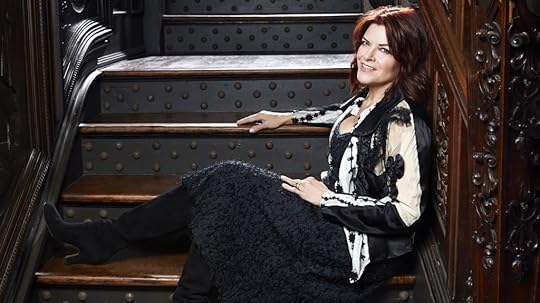
Rosanne Cash. Photo by Clay Patrick McBride.
When Rosanne Cash, recognized by the Library as one of the most compelling figures in popular music, was asked to curate a series of concerts at Carnegie Hall in New York, she graciously brought the American Folklife Center along for the ride. Cash asked AFC to help her curate a photo exhibit, which is being installed outside Carnegie Halls Judy and Arthur Zankel Hall. It will be in place in time for this Saturdays concert featuring The Time Jumpers, which will be the first in Rosannes “Perspectives” series.
In a recent interview, she explained the concerts:
Im really inspired by Southern roots music. Everything from blues to Southern gospel to country pop and Appalachian music. I was born in Memphis and my parents were Southerners, so when I was asked by Carnegie Hall to be a Perspectives artist for the 2015-16 season, I knew immediately that I wanted to curate a series of shows with Southern roots music as the theme. My album ‘The River and The Thread’ had recently been released and music from the Delta and Appalachia was all-consuming for me. I was so honored to be invited and delighted that Carnegie Hall was so enthusiastic about the theme.
Cash sees the concerts as an entertaining way to catch up on Southern roots music history. I wanted to cover different areas of roots music, so I invited The Time Jumpers (October 4), Ry Cooder and Ricky Skaggs with Sharon White (November 4), and a new Alabama soul band called St. Paul and the Broken Bones (January 15, 2016), she explained. My own show, in which Ill play my album ‘The River and the Thread’ in sequence, rounds out the series on February 20, 2016. In that group of artists we cover bluegrass, soul, country, blues, gospel, Appalachian music and more– I think people will be wowed.
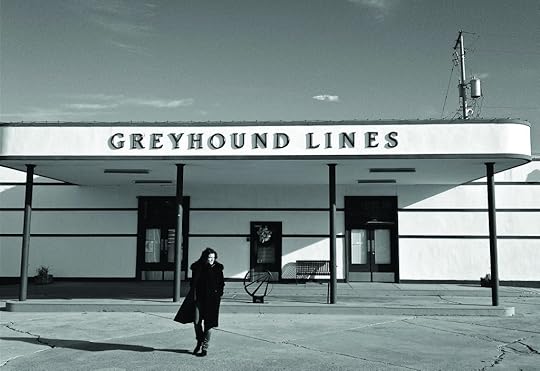
Rosanne Cash visits the Greyhound station in Greenwood, Mississippi, a landmark town in both blues music and the Civil Rights movement of the 1960s. Photo by John Leventhal, courtesy of Rosanne Cash.
It was when she heard that the concert hall included exhibition space for photos that she thought of the Library of Congress, and especially AFC. I called AFC director Betsy Peterson shortly after I was invited, told her the theme, and said, ‘start thinking about images to accompany this music!'”
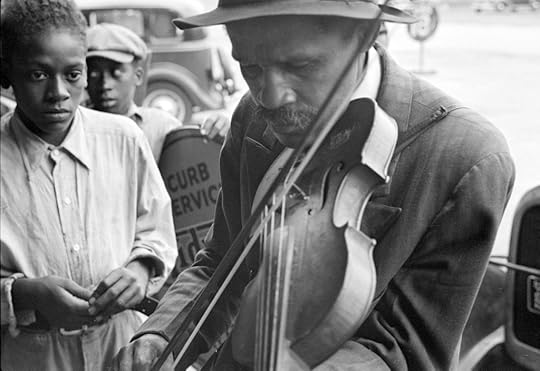
Blind street musician, West Memphis, Arkansas. Photo by Ben Shahn for the Resettlement Administration, 1935. Library of Congress Prints and Photographs Division.
The seeds for this project were sown during Cashs residency at the Library of Congress in December 2013, when she met Betsy and the rest of the staff. That program, spearheaded by the Librarys Music Division and Poetry and Literature Center, included a concert at which Cashs band performed “The River and the Thread,” much like the closing show of the Carnegie Hall series. The first concert with the band at The Library of Congress was such a high, she wrote at the time. We performed my upcoming record in sequence, which was exhilarating. She also participated in a songwriters round-robin in the Coolidge Auditorium with Amy Helm, Cory Chisel, Rodney Crowell, and her husband John Leventhal, which she called a kind of musical combustion. The audience was so warm and the night charged with energy, she remembered.
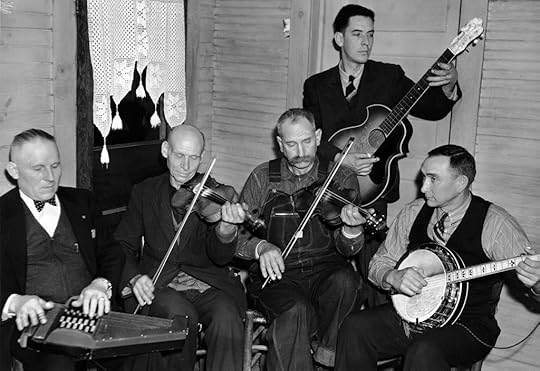
The Bog Trotters Band, Galax, Virginia. Includes bandleader Doc Davis (autoharp), Uncle Alex Dunford (fiddle), Crockett Ward (fiddle), Wade Ward (banjo), Fields Ward (guitar). Photo taken by a CBS photographer for an Alan Lomax radio show, 1937. Library of Congress Prints and Photographs Division.
The final official program of the residency was an on-stage conversation with the Poet Laureate Consultant in Poetry (at the time Natasha Trethewey), which she also remembered fondly:
In the conversation with Natasha Trethewey, I learned that writing poetry and songwriting were identical in process. I knew this, as all creative work has a similar arc of inspiration, problem-solving, completion and editing. But it was exciting to hear Natasha verbalize it.
(You can watch the conversation between Cash and Trethewey in the player below this post!)
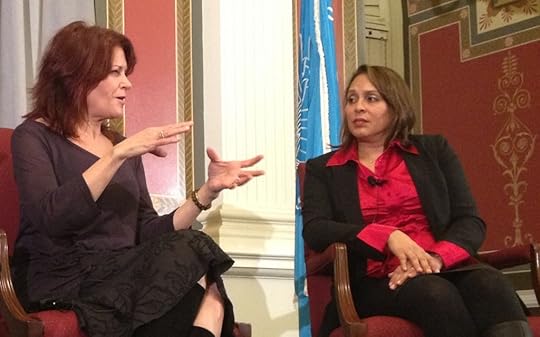
Rosanne Cash and Natasha Trethewey at the Library of Congress, December 7, 2013. Library of Congress photo.
Cash came to know about the American Folklife Center as a result of AFC’s participation in the residency: as a way of welcoming her to the Library, AFC staff put together a display of materials in our collections that we thought might interest her. As she recounted, the materials made her think even more about the Librarys role in preserving American culture:
The curators were kind enough to bring some special items from the American Folklife Center to show usinstruments, field recordings and some old fan magazines of my dad, with photos of my mother and me and my sisters as children. It’s mind-boggling to think what this building preserves, and I’m so grateful they do.
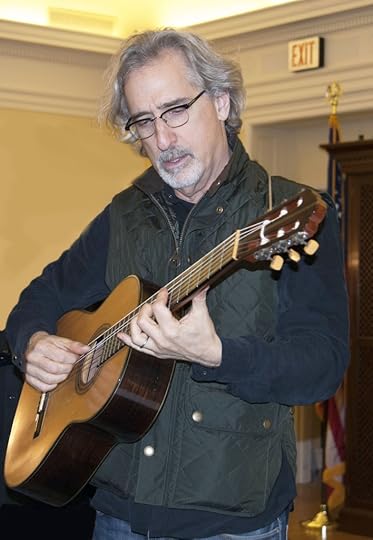
John Leventhal tries out Burl Ives’s Hauser guitar courtesy of the American Folklife Center, in the Library’s Whittall Pavilion. Photo by Stephen Winick for AFC, December 5, 2013.
The items we brought out for Rosanne included the disc sleeve for Rock Island Line, the famous field recording collected by John and Alan Lomax and their assistant at the time, Lead Belly; Rosanne’s father Johnny Cash recorded the song and released it as the first track on his first legendary LP from Sun Records. We found the fan magazines in the Christopher S. Wren Collection, which is made up of research materials for Wrens book on Johnny Cash, including many interviews with Rosanne’s family members. (In addition to the pictures, the fan magazines Wren donated to AFC included Rosannes earliest publication: a poem she wrote at the age of 9.) The main instrument we brought out was Burl Ives’s guitar, which she and all her friends got to play.
We also remembered that AFC has two rare video episodes of TV’s Flatt and Scruggs Show featuring Johnny Cash in 1968, and we invited Rosanne to the AFC Research Center to watch them. She had never seen these clips, and they made a particular impression, especially because they captured Johnnys legendary backing guitarist Luther Perkins on video, only a few months before he died. As Rosanne later told us, Luther was very important to her when she was a young girl, and it was moving to see one of his last performances to be caught on video. I was thrilled, she remembered.
As a result of this experience with AFC, Rosanne immediately thought of the Center when planning the Carnegie Hall exhibit:
I’m nearly obsessed with what the AFC has on their shelves–the carefully collected archives of everything that is important to the preservation of American roots music. I knew they could help find the pictures we needed to put in the glass cases at Carnegie Hall.
The principal work of looking for photos, preparing them for printing, writing captions, and delivering them to Carnegie Hall fell to me. Rosanne and Betsy made the final selections from among a small group I identified as being of possible interest, from among over a million digitized images at the Library.
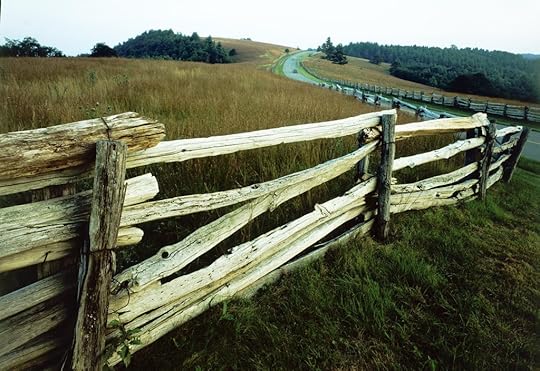
Split Rail fencing in the Doughton Park area of North Carolina, along the Blue Ridge Parkway. Photo by Terry Eiler, September 1978. Library of Congress American Folklife Center AFC 1982/009.
At AFC, Ann Hoog helped me turn up beautiful southern landscapes captured by AFC fieldworkers in the Blue Ridge Mountains and in West Virginia, and Todd Harvey helped find arresting photos of Southern musicians captured by Alan Lomax. (Were grateful to the Association for Cultural Equity for permission to use Lomaxs photos.)
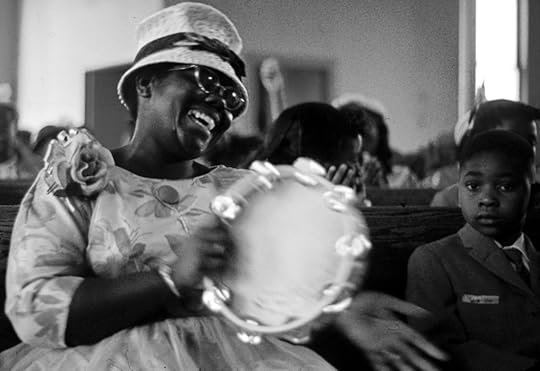
Congregant of the Union Holiness Church with tambourine, Portsmouth, Virginia, 1960. Photo by Alan Lomax, from the Alan Lomax Collection, American Folklife Center, Library of Congress. Courtesy of the Association for Cultural Equity.
In addition to AFCs collections, I used the unparalleled body of public-domain photos available from the Librarys Prints and Photographs division. I found exceptional photos among those shot by Resettlement Administration and Farm Security Administration photographers such as Ben Shahn and Marion Post Wolcott, and exuberant photos of music and southern scenes by Carol Highsmith.

A band gives it the old one-and-a-two at the annual Texas Polka Festival at Sengelmann’s Restaurant in Schulenburg, Texas. Photo by Carol Highsmith, 2014. Library of Congress Prints and Photographs Division.
Finally, Rosanne herself supplied some striking photos, including some pictures by Leventhal of places important to Southern roots music, and a beautiful shot of herself as a toddler in her fathers armsa moving portrait of two great roots musicians. (That photo also served as the frontispiece of a moving article Rosanne wrote about her Southern roots. You can see the photo and the article here!)

This crossroads store, bar, juke joint, and gas station would have been a venue for roots music in Melrose, Louisiana, 1940. Photo by Marion Post Wolcott, Farm Security Administration. Library of Congress Prints and Photographs Division.
Rosanne said she enjoyed the process of working with the AFC curators. It’s always a pleasure, she said. They understand what I love and how much respect I have for them. They’ve been so helpful and so welcoming. I feel I can just stop into the Center any time I want, have a cup of tea and see and hear priceless bits of history.
Related Resources
Below, see Rosanne’s conversation with Natasha Trethewey.
Library of Congress's Blog
- Library of Congress's profile
- 74 followers



